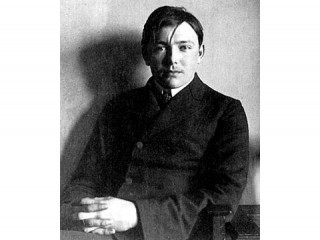
August Macke biography
Date of birth : 1887-01-03
Date of death : 1914-09-26
Birthplace : Meschede, Germany
Nationality : German
Category : Famous Figures
Last modified : 2010-12-28
Credited as : Artist painter, Expressionism, The August Macke Prize 1959
August Macke was a German painter whose harmonious and simple scenes of everyday life made a unique contribution to Expressionism.
Born on January 3, 1887, in Meschede, Germany, August Macke attended the Arts and Crafts School as well as the Academy of Fine Arts in Dusseldorf from 1906 to 1908. His career as an artist spanned only eight short years. He was killed on September 26, 1914, as a soldier in the first weeks of World War I. As a student he contributed costume and stage designs for the Dusseldorf theater (famous for its director and outstanding actress, Louise Dumont). Trips to Italy, Holland, and Belgium culminated in the first visit to Paris, financed by Bernhard Koehler, a famous collector and the uncle of Macke's future wife.
In 1908 Koehler went with Macke to Paris, visiting exhibits and artists, thus providing Macke with an introduction to Cubism and Fauvism, the works of Paul Cezanne and Robert Delaunay. Koehler—through Macke—was also instrumental in providing funds for one of the most important contributions to modern art, the publication of the Blue Rider Almanac in 1911, to which Macke also contributed an article. Koehler also financed in part the largest European avant-garde art exhibit ever held in Germany at that time, the Erster Deutscher Herbst Salon (First German Fall Salon) at the Sturm Gallery of Herwarth Walden in Berlin in 1913.
Macke's half year of study with the famous painter Lovis Corinth was of less importance to his artistic development than his friendship with Franz Marc (after 1910) and his subsequent participation with Wassily Kandinsky in the Blue Rider Group. Macke was not very interested in the theoretical concepts of either Kandinsky or Marc; his vitality, his love for life, led him to experiment with various forms on his own, developing a variance of Cubism based on his special relations to colors. From early on, Macke chose as his main themes simple, everyday scenes from the life he loved so much. Neither the speed of modern life nor the tranquility of rural sites held any fascination for him. He painted modern, often elegantly dressed, human figures in quiet, harmonious, man-made surroundings: in parks, in the zoo, on the banks of rivers, or in front of shop windows, as well as scenes from the circus. There is no haste in the movements of his figures: quiet conversations, people reading or watching animals or the river flow by, scenes rarely found elsewhere in German Expressionism.
Macke was fascinated by the power of color to construct space and distance, permitting him to make figures and surroundings equally important. He ordered his abbreviated forms in carefully balanced color variations, avoiding the frequently apocalyptic and fantastic forms of his friends of the Blue Rider Group. The influence of Delaunay's "orphic" colors is easily recognized in Macke's work, but his vigorous and strong temperament translated the various influences into paintings which are independent and unique and—in strong contrast to most expressionistic works of the period—closely allied to the French developments in the arts.
Macke also produced small sculptures, designed stained-glass windows, and made designs for embroideries. He actively participated in two important modern exhibitions: the exhibition of Rhenish Expressionists in Bonn as well as the First German Fall Salon in Berlin in 1913. His greatest artistic achievements, promising even more succinct accomplishments, were made in 1914. Again with the help of Bernhard Koehler, he travelled with Paul Klee and an old Swiss friend, the painter Louis Moilliet, to North Africa, Tunis, and Kairouan. Paul Klee remarked later that it was this trip which provided him with the true understanding of color, probably in part under Macke's influence. Macke's many watercolors and sketches show strong response to the Mediterranean light, the different forms of North Africa, and the appreciation of the extraordinary local colors.
Macke's simple and direct approach to everyday life, his carefully balanced compositions, and his lively colors all enhanced his images of the column-like figures. The serene and balanced visions show a world of visual poetry which separates him from the more forceful works of his expressionist friends and establish for him a special position in this early development of modern art.
Macke's oeuvre catalogue has been published by Gustav Vriesen (2nd edition, Stuttgart, 1967). His letters exchanged with Franz Marc were published, edited by Wolfgang Macke (Cologne, 1964) and recollections were made public by his widow, Elisabeth Erdmann-Macke (Stuttgart, 1962). Valuable contributions were made in the books by Gunter Busch (Cologne, 1956), M. T. Engels (2nd edition, Recklinghause, 1958), and Walter Holzhausen (Munich, 1956). As in all cases of the German Expressionists, the various exhibition catalogues are of importance. An important exhibit was held in 1979 at the Citymuseum of Bonn, "Die Rheinischen Expressionisten" (The Rhenish Expressionists), edited by Dierk Stemmler, which places Macke in the midst of his contemporaries. A small monograph on Macke's painting, "Das Russische Ballett" (The Russian Ballet) (Stuttgart, 1966), by Gunter Busch is a useful interpretation. Gunter Busch also published an evaluation of Macke's drawings (Hamburg, 1966). The Westfälisches Landesmuseum fur Kunst und Kulturgeschichte, Munster, holds 78 sketchbooks of Macke. A large collection of Macke's works is in the Städtische Kunstmuseum, Bonn.
















